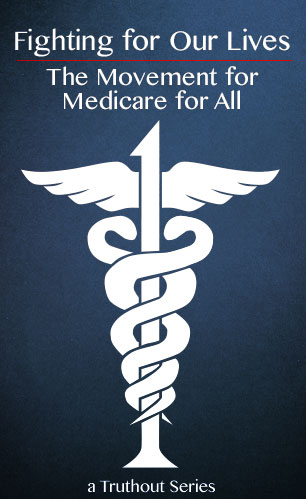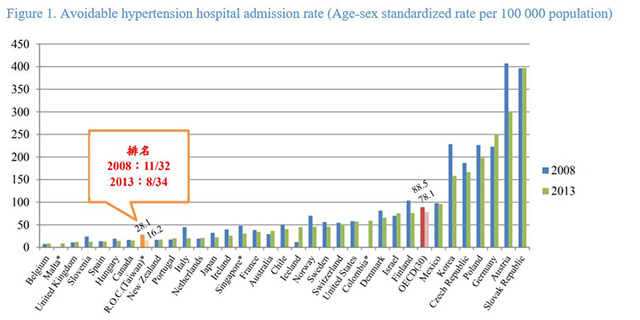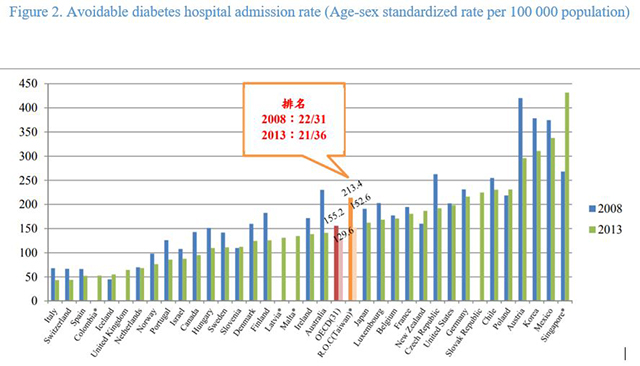
Part of the Series
Fighting for Our Lives: The Movement for Medicare for All
Honest, paywall-free news is rare. Please support our boldly independent journalism with a donation of any size.
This piece is part of Fighting for Our Lives: The Movement for Medicare for All, a Truthout original series.
“Taiwan’s highly efficient system of national health insurance should humble and inspire the United States.” —Uwe Reinhardt (1937 – 2017)
There are obvious reasons why some people in the United States oppose the prospect of single-payer health care. Taking the profit out of health care — a moral imperative and the norm internationally — poses a major threat to the pharmaceutical industry, insurance companies and others. These interests spend millions donating to and lobbying powerful politicians in both parties. The goal is to do what corporations are designed to do: maximize profit regardless of its impact on outside stakeholders and the public at large.
Capitulating to the donor class is never a good look for politicians, so lobbying and campaign finance are virtually never the stated reasons for opposition to a better health care system. The actual reasons for opposition are often quite separate from the explanations offered to the public.
This is especially true for Democrats. Conservatives can point to their reverence for the “free market” and their open hostility to “lazy” “welfare freeloaders” — stereotypes that are patently false, but still pervasive in right-wing circles. Liberal critics of single-payer health care don’t have that ideological argument to lean on. Democrats often make bold proclamations that health care is a “human right,” even when they display open resistance to Medicare for All legislation — the only legislation in Congress that would create universal health care.
This is an especially delicate situation for Democrats since some polls show that 80 percent of Democratic voters support Medicare for All, and 65 percent say they would support “single-payer” even if it included a tax hike.
One common tactic is to claim that single-payer is not a bad idea, but just logistically impossible. Implementation is a pipe dream, Democratic opponents argue. The Clinton campaign (and many of its surrogates) made repeated false claims of this nature, arguing that the transition would hurt Americans and empower right-wing governors, and would simply “never, ever happen.” Paul Krugman was a champion of single-payer for years, but is now just repeating the establishment line. The wonks at Vox typically advance similar arguments, praising market solutions while mocking Medicare for All.
If these critics are sincere in their skepticism, they would benefit from a conversation with William Hsiao, a Harvard professor who knows as much about sweeping health reform and the implementation of single-payer as anyone in the US.
“For US policy makers the speed of Taiwan’s move to a national health insurance system seems downright surreal.”
He built such a system in Taiwan, with rapid and unambiguous success. Taiwan went from having about 43 percent of its people uninsured to universal coverage in just a few years, all while improving outcomes and keeping costs to just 6 percent of GDP.
(The US, by contrast spends about 18 percent of GDP on health care.) In light of this success story, Hsaio was awarded a presidential medal in recognition of his work in Taiwan, 20 years after that country’s National Health Insurance (NHI) system became a reality.
In an interview with Truthout, Hsaio said there is a lot the United States can learn from Taiwan and the rest of the world about creating an equitable, public health system like Medicare for All.
“There is no question the United States would benefit economically from a single-payer plan,” he said. “Study after study show that it would save money. We have witnessed [this] in Taiwan and elsewhere across the globe.”
If You Build It: Taiwan’s Path to Single-Payer
The NHI was created at the behest of then President Lee Teng-hui in 1995. At the time, 57 percent of people in Taiwan had health insurance, mostly government employees, farmers and fisherman. Often insurance plans did not cover families, Hsaio said. Teng-hui felt he had the political capital and popular support to create a universal health care system. Hsaio was hired to lead a team of four Taiwanese professors and 16 other technical experts.
“It turned out to be a big advantage that I’m not Taiwanese and had no aspirations of getting a job in Taiwan,” Hsaio, who is Chinese American, told The New York Times in 2009. “At the end of the day, our recommendations and findings were perceived as more objective and free of self-interest.”
What stands out first is how quickly the process went. The legislative and political process to establish single-payer in Taiwan lasted about 18 months during 1993-94, according to a report by Uwe Reinhardt, a leading health scholar and Princeton professor who died last month. The NHI officially went into effect March 1, 1995.
 “[I]t was implemented in less than a year. Overnight, health insurance coverage in Taiwan jumped from roughly 57 percent of the population before [March 1] to virtually the entire population,” Reinhardt said. “For US policy makers and presidential contenders — who for half a century now have engaged in a perpetual “national conversation” on universal health insurance … the speed of Taiwan’s move to a national health insurance system seems downright surreal.”
“[I]t was implemented in less than a year. Overnight, health insurance coverage in Taiwan jumped from roughly 57 percent of the population before [March 1] to virtually the entire population,” Reinhardt said. “For US policy makers and presidential contenders — who for half a century now have engaged in a perpetual “national conversation” on universal health insurance … the speed of Taiwan’s move to a national health insurance system seems downright surreal.”
Hsaio explained the timeline. “We had the insurance rate up to 95 percent almost right away. Over the next couple of years that went up as we found people who hadn’t enrolled and were harder to reach,” he told Truthout. The government took significant outreach steps, like sending staff out to the streets to enroll homeless people who had not yet entered the NHI.
Did this reform cause the disruptions the US corporate media and Democratic establishment claim are inevitable? Did it result in “chaos,” and “undo people’s health care,” to quote Howard Dean’s scare tactics? Did it “require substantial disruptions,” which The New York Times reported would be inevitable for “nearly any single-payer plan”?
Nope. In fact, the transition was successful and led to a more cost efficient and equitable system. It offers comprehensive benefits, including dental, hospital care and acupuncture, and allows patients to choose any provider they want at any time. There are small co-pays of $5 or so for a check-up, but these can be waived for low-income patients and are capped to prevent bankruptcy. The people of Taiwan have an 83 percent satisfaction rate with the NHI, compared with 63 percent in the United States. That latter number is inflated, since the highest satisfaction rates come from those with Medicare, and the Veterans Administration, which are basically single-payer systems. Only 41 percent of uninsured Americans are satisfied with health care. In September, the ReviveHealth Trust Index found that “trust in health plans is at an all-time low,” and “[t]wo-thirds of respondents said they would prefer ‘Medicare for all”Medicare for all’ over the current healthcare system.”
Taiwan’s system allows for savings in part due to the increased purchasing power of a national risk pool. “As a single payer, Taiwan’s NHI is able to exercise its [sole purchasing] power to manage its health expenditure growth,” concludes a November study published in Social Science and Medicine that examined the costs of single-payer and multi-payer systems.
Savings also come from a decrease in administrative waste. According to a paper written by Raymond Kuo of the National Taiwan University and others in the London Journal of Primary Care, “Owing to the single insurer system, Taiwan’s NHI has one of the lowest administrative costs in the world, typically under 2 percent of total healthcare spending.” In the US, it is estimated that a third of US health dollars are spent on paperwork, and the Commonwealth Fund reports that 25 percent of hospital costs go toward administrative expenses, the highest of all countries studied.
“The cost of health care in Taiwan is low, but the quality of care is good when compared to [Organisation for Economic Cooperation and Development] countries,” said Kuo, in an interview with Truthout. “[P]atients may be treated by any provider they choose, regardless of their [income] level. Patients may even self-refer themselves to large hospitals for primary care. The waiting time for elective treatment is short. Same-day appointments for an [outpatient] visit is possible for most of the cases.”
Kuo provided Truthout with charts showings Taiwan’s improved rankings for key health metrics such as: diabetes and hypertension (see figures 1, 2).
 (Source: Raymond Kuo)
(Source: Raymond Kuo)
 (Source: Raymond Kuo)
(Source: Raymond Kuo)
An American in Taiwan
Marjorie Freimuth, a travel writer and enthusiast, lived and worked in Taiwan for two years, using the NHI several times. Her overwhelmingly positive experiences prompted her to write about her interactions with the system in an essay for HuffPost.
“I wanted people to know that experiences like that exist,” she said an interview with Truthout. “I wanted to get the word out to America that going to the doctor, or even paying for insurance, doesn’t have to break the bank.”
Freimuth said she was able to get check-ups for $5, and antibiotics for free. Dental work was all covered, save for the $5 co-pay.
“[The low cost was] one of the things that really shocked me … an incredible deal compared to the US,” she said. “And the quality of care was very high as well.”
Will the US Look Around the World for Help?
Asked if the US should study Taiwan’s health system, Freimuth replied, “The U.S. could benefit from studying any system!”
“I think we’re so ingrained in the way our own system is set up, nonsensical as it may be, that often we don’t realize that other options exist, and may even be better,” she said. “We’re trying to patch up an inherently broken system instead of starting from scratch on a system that could work, or at least has the potential to work better.”
Freimuth’s suggestion that the United States look for inspiration abroad resonates with the approach Hsaio took in Taiwan. When his team was forming the new Taiwanese health system, they looked at the health systems of numerous other countries — including Canada, the United Kingdom and even the US Medicare system — to see what worked.
“The [NHI] is most like the Canadian model, but we studied a lot of different systems and tried to learn from each one,” Hsaio said.
This look-abroad approach is not lost on Sen. Bernie Sanders. The Vermont senator, who introduced a Medicare for All bill this year, recently took a coalition of doctors, nurses and other stakeholders on a Canadian hospital tour, as Truthout reported in October.
So, much of what we hear about single-payer from politicians and the media assumes that the US is, for some reason, unique in that it must treat health as a commodity, even though the majority of the international community finds that to be inhumane.
But looking around the world, we see that smart people can and do implement smart, humane policies that guarantee health care as a right, despite tremendous obstacles.
“You can have universal coverage and good quality health care while still managing to control cost, with a single-payer system,” Hsaio says. “It will require strong public support, but we are seeing momentum in the United States now.”
Consider that Canada implemented a universal system in 1984 and had similar public support for single-payer as we are now seeing in the US prior to its implementation. Taiwan’s NHI was implemented 22 years ago and was done so with remarkable efficiency, even though Taiwan’s problems with access were many times worse than what the United States faces today. South Korea implemented a single-payer system over 12 years, much slower than Taiwan, but still a “remarkable achievement,” as Jong-Chan Lee wrote in the American Journal of Public Health, from which “there are lessons to be drawn for the United States.”
There are no apples-to-apples comparisons when it comes to national health care; no two countries are exactly alike. But the notion that single-payer can “never, ever happen,” is refuted by the significant achievements in social insurance around the globe. These nations cannot only provide practical lessons in implementation, but also a tremendous amount of inspiration to take better care of one another in the United States.
Media that fights fascism
Truthout is funded almost entirely by readers — that’s why we can speak truth to power and cut against the mainstream narrative. But independent journalists at Truthout face mounting political repression under Trump.
We rely on your support to survive McCarthyist censorship. Please make a tax-deductible one-time or monthly donation.